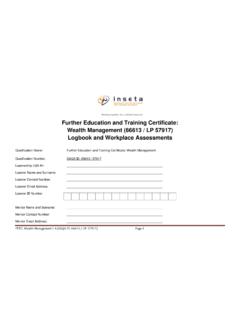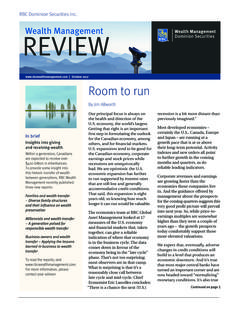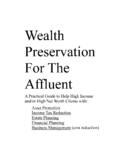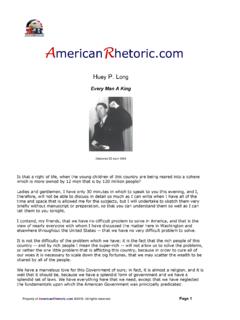Transcription of EY Wealth Management Outlook 2018
1 EY Wealth Management Outlook . 2018 . Anticipating and seizing global growth potential in a challenging environment Executive summary 1 The global volume of net investable assets of high-net-worth individuals (HNWI+) will increase by around 25% to almost US$70 trillion by 2021. 2 Holistic Wealth Management will emerge as a new kind of digitalized business model. Holistic Wealth managers are expected to gain a market share of 30% by 2025. 3 Wealth managers with traditional business models will largely disappear from the market as a result. Traditional Wealth managers located in or operating out of the United 4 States are likely to survive in the international offshore business thanks to increasingly favorable conditions. 5. The service offering of Wealth managers with an offshore business model will increasingly mirror that of onshore Wealth managers.
2 Editorial Global Wealth Management is undergoing unprecedented transformation The years following the financial crisis have seen significant developments in the financial services sector. Global Wealth managers now face the challenge of adapting to a market environment that is evolving quickly, if not revolutionizing. Client needs, shareholder expectations, stricter new regulations and milestone developments in technology are driving future business models and shaping their requirements. While we must wait to see the full impact of these changes, it is already clear that new industry structures will emerge in the coming years. Adapting early to the new reality will open the door to profitable future growth opportunities. This report discusses global opportunities and challenges, examines the drivers of structural change and explores the business model options available to Wealth managers wishing to seize the global potential and survive in the business long term.
3 I hope you enjoy reading this report and find our insights into the Wealth Management market thought-provoking. Serkan Mirza Executive Director, Wealth & Asset Management Strategy Consulting, Switzerland Ernst & Young AG. Contents 1. Wealth Management 6. Multidimensional challenges defining the playing field 2. 12. of Wealth managers Complex client needs 13. Digitalization enables a more accurate needs fulfillment 14. Regulation means transparency 15. Shareholders seek profitable growth 15. 3. Old business models need to be rethought to capture the potential 16. 4. The struggle between onshore and offshore 20. 5. Let the games begin 22. Wealth Management a market worth over US$55,000 billion Its size and growth make the HNWI+1 segment of the global Wealth Management market particularly attractive. Today's market for net investable assets (NIA)2 already exceeds US$55,000 billion.
4 According to our EY Global Wealth Model, global NIA will reach US$69,607 billion by 2021, increasing by almost one-quarter of the current volume, or at an annual growth rate of through 2021. Wealth managers should be anticipating and seizing this market potential and enormous growth now. Total net investable assets of HNWI+3 [US$ in trillions; absolute growth 2016-21]. 2016 Absolute growth 2021. Regional distribution of growth in Others NIA of HNWI+4 [US$ in trillions; absolute growth 2016-21]. USA. Top 6-20. 1. 31. China India Brazil Russia 1. HNWI+: NIA > US$1 million 2. Net investable assets (NIA) defined as financial assets, collectibles and precious metals held by HNWI+, less financial liabilities, main residence, durables and consumables. 3. EY Global Wealth Model 2018 (see page 24, EY Global Wealth Model methodology ).
5 4. Ibid. EY Wealth Management Outlook 2018 | 7. A look at individual markets reveals that more than half of global NIA growth through 2021 stems from the top five ranking countries. The US and China alone account for over 45%. Another 10% of the increase is attributable to Russia, Brazil and India, which rank three to five. It is worth noting that the next 15 countries are not far behind India, however, meaning that the 18 countries ranking below the US and China (including Russia, Brazil and India). make up around 38% of global growth. NIA of HNWI+ in top 20 countries5 [US$in trillions; absolute growth 2016-21]. Sweden Norway USA Russia France Canada UK Germany Turkey Netherlands China Italy South Korea Saudi United Arab Arabia Emirates Mexico India Brazil Indonesia Australia From a regional perspective, we expect North America to see the largest growth in NIA.
6 Although this region can be seen as a mature and well-established market, with growth of around compared with global growth of , its integrated market and common language make it extremely attractive nevertheless. The pursuit of personal success and a healthy risk appetite are embedded in a corporate culture that drives innovation and contributes to private Wealth accumulation. 5. EY Global Wealth Model 2018 (see page 24, EY Global Wealth Model methodology ). 8 | EY Wealth Management Outlook 2018 . Total NIA of HNWI+6 [US$ in trillions; annual growth rates; 2016 21]. North America Eastern Europe Western Europe Asia-Pacific + + + + 2016 2019 2021 2016 2019 2021 Middle East 2016 2019 2021 2016 2019 2021. + Africa Latin America + 2016 2019 2021. + Global 2016 2019 2021. + 2016 2019 2021 2016 2019 2021. With expected above-average growth of and a high increase in NIA, nations in Asia-Pacific can be viewed as rapidly developing and weighty co-players, adding to the region's appeal.
7 Entrepreneurship is blooming, nourished by access to financing options, an educated workforce and an outstanding work ethic. The development is creating regional investment opportunities for HNWI+ and driving growth. Centers of innovation, such as Singapore, are viewed as appealing for companies because of their effective infrastructure and state support. Moreover, double- taxation treaties, free-trade agreements and investment treaties are making foreign trade easier. One exception here is Japan, which is expected to see minimal annual growth of Nevertheless, the country remains an interesting market with absolute NIA growth of more than US$140 billion. 6. EY Global Wealth Model 2018 (see page 24, EY Global Wealth Model methodology ); Japan is not included in the analysis of Asia-Pacific, such that the sum of all regions presented is somewhat lower than the global total.
8 Latin America includes the Caribbean. EY Wealth Management Outlook 2018 | 9. We see Africa and the Middle East in particular as markets that will return above-average growth in the future. Apart from petroleum and natural gas, large areas are geared toward the export of precious metals and diamonds. Private companies and financial institutions in the Middle East benefit on account of their geographical location from the flourishing trading business and trade finance. A high global influx of capital in the form of development aid from supranationals, together with free trade agreements directly promoting foreign private investment, culminate in the expansion and improvement of infrastructure and sustainable economic growth. In 2014 and 2015 alone, foreign private investors injected capital investments of over US$200 billion7 into large-scale projects on the African continent.
9 Besides Saudi Arabia, the largest economy in the Middle East, Iran is set to drive private Wealth accumulation in the region following the lifting of economic and financial sanctions related to the country's nuclear power activities. However, market fragmentation due to the large number of countries, the cultural diversity and unstable political conditions in various states creates an ambivalent and challenging environment in which developments are often difficult to predict. Accounting between them for an increase in NIA of US$700 billion, Brazil and Mexico are the driving forces behind growth in Latin America. Brazil faces the challenge of weakening factors it relied on for growth in the past, such as rising employment or flourishing commodity trading. To counteract this trend, future growth should increasingly be generated through higher investment and productivity.
10 This would create interesting opportunities for wealthy private investors. Mexico pursues a sustainable economic growth strategy with political reform, including deregulation of energy and telecommunications markets, coupled with international trade agreements. Similar to North America, Latin America has the advantage of a relatively integrated market and a largely uniform language base. However, in view of the most recent political and social tension, we expect below-average rates of private Wealth accumulation. With the United Kingdom and Germany, Western Europe is home to two of the major growth engines for global NIA, although Brexit is currently hindering economic activity to a certain extent. Despite economic sanctions and geopolitical tensions, Russia remains an interesting market. Boasting an above-average number of HNWI+, the country is the main contributor to the increase in NIA in Eastern Europe.
















